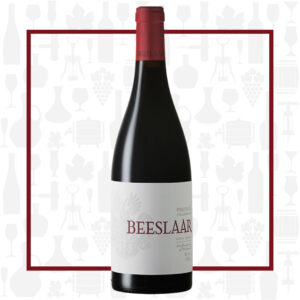Cellar Profile
Having grown up in a wine region, it wasn’t entirely surprising that Abrie Beeslaar changed from studying medicine at the University of Stellenbosch, to graduating with a BSc in Viticulture and Oenology from there. In 2003, Abrie became the Head Winemaker at acclaimed and iconic winery (and Pinotage specialist), Kanonkop. There, he discovered a tiny, 2.5 hectare, old bush-vine-trained Pinotage vineyard near Simonsberg Mountain, outside Stellenbosch that had the perfect conditions for creating magnificent wines. Shale soils, easterly breezes and significant diurnal shifts, coupled with the bush vines’ penchant for giving small bunches of tiny, ripe berries give the wines intensity of colour and concentration. Beeslaar Estate Pinotage is vinified similarly each year, but the finished wine always tells the tale of the vintage and is generally regarded as amongst the finest examples of Pinotage in the world. The winery recently added a small production of Western Cape Chardonnay to its line up.
Region
Located just at the edge of the Stellenbosch appellation, 45 km from Cape Town, Simonsberg has been actively planted since the 17th century. It is a small region, known for crafting some of the finest examples of South African wine. Located in the foothills leading to the Simonsberg Mountains towering above it, it is bordered by Stellenbosch, Paarl and Franschhoek. Simonsberg enjoys a Mediterranean climate, with cool, wet winters and hot summers, mitigated by a strong easterly wind and fairly significant diurnal shifts.
Vineyard
Old vine vineyard, situated in Simonsberg, just outside Stellenbosch. At 200 masl, the bush trained vines are planted in shale soil. There is a strong, easterly breeze that whistles through the vineyard, cooling the grapes and restricting growth of the bush vines, keeping berry sizes and clusters smaller, allowing for full phenolic ripening of the skins, vital for top notch Pinotage.
Varieties
Pinotage is a South African crossing of Pinot Noir and Cinsault. It is typically found in South Africa (Stellenbosch), but its brambly nature, ability to maintain a level of freshness even in hot conditions and consistency vintage to vintage has found it being increasingly planted worldwide. It doesn’t crop as hugely as some reds, but still gives decent yields. Attention in the vineyard must be observed to avoid isoamyl acetate, which gives off unpleasant drying paint notes. An unabashedly “New World” variety.
Winemaking
Hand-harvested estate fruit is sorted, then pressed into open top concrete containers, where the juice macerates for 3 days, with manual punchdowns every 2 hours. The wine is then transferred into small French oak barriques, made from mature forests, for 20 months of aging before being bottled unfined and unfiltered.
Tasting Notes
Concentrated aromas of black cherries, sweet baking spices, ripe strawberries and plum. You won’t find any of the off-putting vinyl notes or overly-confected chocolate aromas of lesser examples of Pinotage. The nose has a perfumed character, with an underlying earthy tone. Beautifully poised and elegant, with fine tannins to support the broad, plush fruit. The palate is mouth-filling and balanced, with lingering savoury notes on the finish and that signature South African gaminess. Pair with roast beef, lamb chops or hearty venison stew.

 info@buyersandcellars.ca
www.buyersandcellars.ca
info@buyersandcellars.ca
www.buyersandcellars.ca